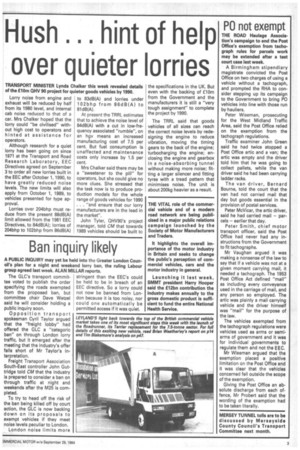Hush . hint of help over quieter lorries
Page 5

If you've noticed an error in this article please click here to report it so we can fix it.
TRANSPORT MINISTER Lynda Chalker this week revealed details of the £10m QHV 90 project for quieter goods vehicles by 1990.
Lorry noise from engine and exhaust will be reduced by half from its 1980 level, and internal cab noise reduced to that of a car. Mrs Chalker hoped that the lorry could "be civilised" without high cost to operators and hinted at assistance for operators.
Although research for a quiet lorry has been going on since 1971 at the Transport and Road Research Laboratory, EEC Directives agreed on September 3 to order all new lorries built in the EEC after October 1, 1990, to have greatly reduced noise levels. The new limits will also apply from October 1, 1989, to vehicles presented for type approval.
Lorries over 204bhp must reduce from the present 88dB(A) limit allowed from the 1981 EEC Directives, to 84dB(A); lorries of 204bhp to 102bhp from 86dB(A) to 83dB(A) and lorries under 1 0 2 bhp from 8 6dB(A) to 81dB(A).
At present the TRIRL estimates that to achieve the noise level of 84d6(A) with a cut in low-frequency associated "rumble", on an hgv means an increased manufacturing cost of 7.5 per cent. But fuel consumption is unaffected and maintenance costs only increase by 1.5 per cent.
Mrs Chalker said there may be a "sweetener to the pill" for operators, but she could give no more clues. She stressed that the task now is to produce production models for the whole range of goods vehicles for 1990
. . . and ensure that our lorry manufacturers are in the lead in the market".
John Tyler, QHV90's project manager, told CM that towards 1989 vehicles should be built to
the specifications in the UK. But even with the backing of £10m from the Government and the manufacturers it is still a "very tough assignment" to complete the project by 1990.
The TRRL said that goods vehicles of all sizes can reach the correct noise levels by redesigning the engine to reduce vibration, moving the timing gears to the back of the engine; turbocharging the engine; enclosing the engine and gearbox in a noise-absorbing tunnel without making more noise; fitting a larger silencer and fitting tyres with a tread pattern that minimises noise. The unit is about 200kg heavier as a result.
THE VITAL role of the commercial vehicle and of a modern road network are being publicised in a major public relations campaign launched by the Society of Motor Manufacturers and Traders.
It highlights the overall importance of the motor industry in Britain and seeks to change the public's perception of commercial vehicles, cars and the motor industry in general.
Launching it last week, SMMT president Harry Hooper said the E12bn contribution the industry makes annually to the gross domestic product is sufficient to fund the entire National Health Service.
















































































































